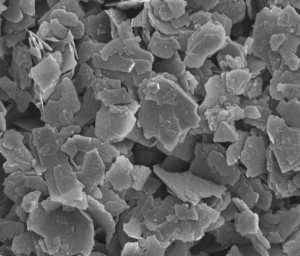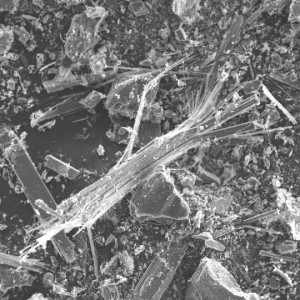This past week has seen a number of headlines about the Johnson & Johnson been awarded a jury verdict requiring them to pay $73 million to the family of a woman who died of cancer, which was claimed to be caused by the material in the Johnson & Johnson talc based Baby Powder. [Ref. 1] The jury found Johnson & Johnson liable for fraud, negligence, and conspiracy according to the family’s lawyers. The case has created concerns regarding the safety of using talcum powder. Both Baby Powder and Shower to Shower products are made of talc, which are mineral rocks that contain magnesium, silicon, and oxygen, while some forms can contain asbestos. [Ref. 2] Everyone knows asbestos is a potential carcinogen. As pointed out in an article [Ref. 3], both talc and asbestos are categorized as silicates, containing both silicon and oxygen. To further complicate the situation, the pictures of talc [Figure 1] and talc with asbestos [Figure 2 with the long cylindrical shaped material on the talc flakes] are available. [Ref. 4 & 5]. So, talc with asbestos has the potential to be an issue. However, asbestos has been removed from any talc product since the 1970s.
Figure 1 Figure 2
So where does this lead to? First, the Cancer.org site [Ref. 6] states that talc as a powder absorbs moisture and cuts down on friction making useful to help prevent rashes. The site indicates that there is a need to differentiate between talc that contains asbestos and talc that is asbestos-free. There are conclusions from studies that indicate that asbestos-free talc is classified as “not classifiable as to carcinogenic to humans.”
The final resolution of this and other similar cases will take years to play out. There will be a number of articles and news reports indicating the “problems” with talc. At the same time, additional screening studies will be developed, conducted, and the outcomes evaluated.
The point of this blog is that we live in a world where sensational headlines make the news. The fact that talc has a mineral composition that also occurs in asbestos provides a topic for reporting that talc is the same, which it is not. The availability of pictures showing the asbestos with talc powder implies that the powder is dangerous. There was even a report that indicated talc has shapes like asbestos. Obviously, some looked at a picture of talc with asbestos and thought it was all talc. Instant self-publishing becomes an issue when a person sees something and makes an incorrect association which is then published.
The caution that the article on the talc verdict brings is twofold. First, the jury award is not final, and even if it is settled without any contesting, there was no proof that the talc was responsible for the woman’s death from cancer. There are a number of explanations in the references below that indicate there might be a link, the probability is very low. Second, the rapid reporting of an announcement like this will stay on the web regardless of the final outcome. This fact implies that as more and more articles, blogs, etc., are developed, it will be harder and harder to find out accurate information.
References:
- http://www.reuters.com/article/us-johnson-johnson-verdict-idUSKCN0VW20A
- http://www.independent.co.uk/life-style/health-and-families/health-news/does-talcum-powder-cause-cancer-johnson-johnson-baby-powder-shower-to-shower-a6894926.html
- http://www.thedailybeast.com/articles/2016/02/24/can-baby-powder-really-cause-cancer.html
- http://www.nanoshel.com/product/talc-nanoparticles/ talc nanopowder
- http://usgsprobe.cr.usgs.gov/picts2.html Anthophyllite asbestos altering to talc, upstate NY
- http://www.cancer.org/cancer/cancercauses/othercarcinogens/athome/talcum-powder-and-cancer
- http://www.safetyandcarecommitment.com/ingredient-info/other/talc?&utm_source=google&utm_medium=cpc&utm_campaign=J%26J+-+Talc+Powder&utm_term=talcum%20powder%20cancer&utm_content=J%26J+Talc+Safety+-+E|mkwid|s9MN8PMFz_dc|pcrid|85363851134 Johnson & Johnson’s statement on their talc products.


